The task is not so much to see what no one yet has seen, but to think what no body yet has thought about that which everyone sees. -Arthur Schopenhauer
Most of you who've been reading Starts With A Bang for a while have seen this picture come up many, many times.
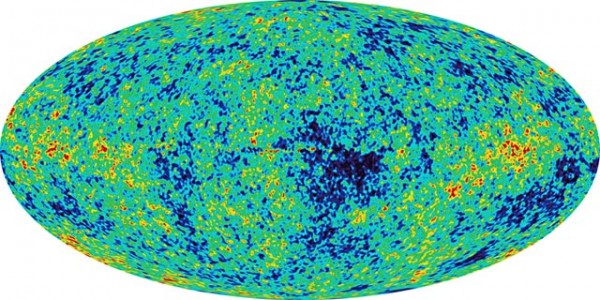
Why do I keep putting it up, and why is it so important?
Let's go back to the 1960s for a little bit. Back then, there were two major rival theories about the origin of the Universe: the Big Bang theory and the Steady-State model of the Universe. The Big Bang contended that the Universe was hotter and denser in the past, and thus of a finite age, while the Steady-State theory contended that the Universe has always been the same temperature and density as it is today.
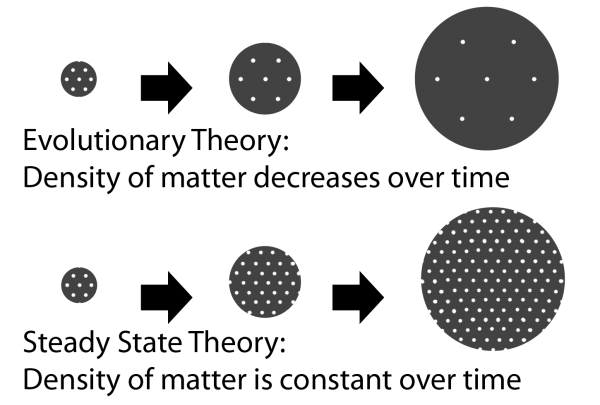
One huge difference between these theories? The Big Bang says that at one point in the Universe's past, it was so hot and dense that a thermal bath of radiation dominated everything, and that radiation -- untouched since the Universe cooled enough to form neutral atoms -- should still be leftover today.
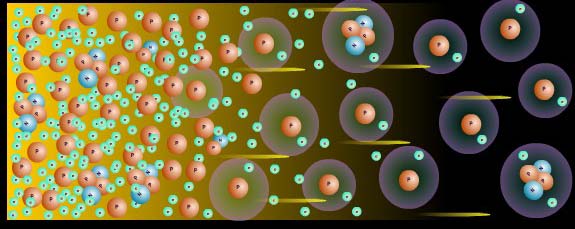
It should be much colder now, only a few degrees above absolute zero, but it should still be around.
By contrast, the Steady-State model said that the only light that should be around is starlight, either coming directly from stars or reflected off of the gas throughout the Universe.
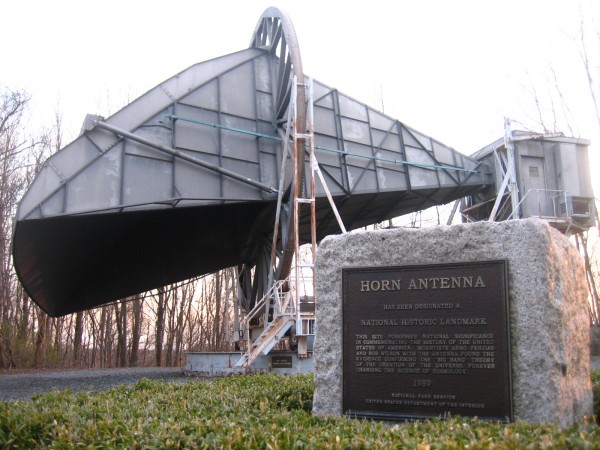
Well, in the 1960s, Arno Penzias and Bob Wilson used this piece of equipment (above) -- the Horn Antenna -- to measure microwave-frequency radiation. What they found was that radiation was coming from everywhere in the sky (that they could measure) with the same exact energy!
Over the past 45 years or so, we've confirmed that this energy is peaked practically exactly at 2.725 Kelvins -- just a slight bit above absolute zero -- everywhere in the sky! It corresponds identically to the leftover glow predicted by the Big Bang, and contradicts the predictions of Steady-State theory.
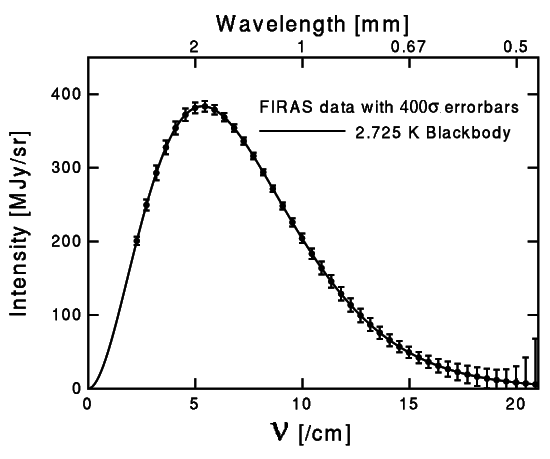
(The hardcore among you will see the 400-sigma error bars and gasp. That is not a typo!)
It wasn't until 2003 that a detailed map of the variations in the sky -- the departures from 2.725 Kelvin -- were measured. These fluctuations were only a few microKelvins, or millionths of a degree, and here's what they look like.
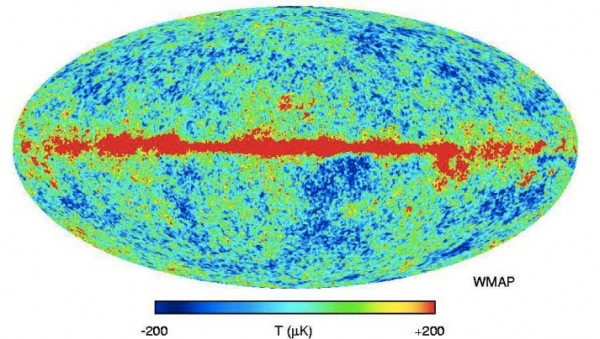
(This map, by the way, is the entire sky spread out into an ellipse, known as a Mollweide projection.)
These fluctuations will tell us a whole bunch of information about the Universe, including what types of structures will form, how old the Universe is, how much normal matter, dark matter, and dark energy are in it, how important neutrinos are, and many other things.
But not like this, they won't. You see, this map has an awful problem with it. Not only is our galaxy in the way,

But a bunch of strong extragalactic microwave- and radio-sources are out there too, mucking up our picture! So what do we need to do? We make a "mask" as best as we can, to remove the offending parts of the picture. (Shown in red, below.)
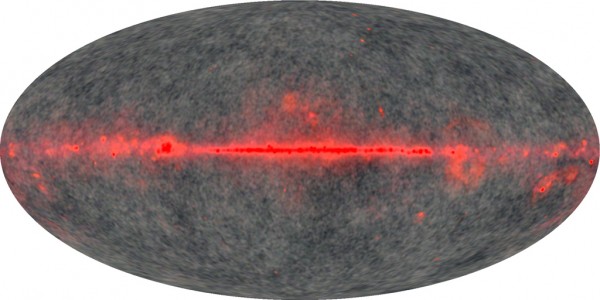
Without this data from the cosmic microwave background, we can still learn a whole lot about the Universe, including its age, the presence of dark matter and dark energy. But we couldn't do it as accurately as we can from the fluctuations in this microwave background.
Well, a new paper came out earlier this year, in which the authors claim to have found a problem with the mask used by looking at distant, luminous red galaxies.
My take on it? This is a real issue that needs to be understood. If we're using the wrong mask, that means we're either throwing out real data, which is bad, or we're keeping bad data, which is worse. The problem areas are, for example, circled in white in the image below.

And what this goes to show (by my accounts) is that we're not done fully analyzing this data yet! There's a lot to learn about the Universe, and this is the best data set we have (so far) to do so. That's why we'd better make sure we're getting it right!
And I don't have a problem, at all, with the way they present their results. And yet, I want to smack somebody because of this. Robert Massey, I am calling you out. From the PhysOrg website:
Sawangwit and Shanks used astronomical objects that appear as unresolved points in radio telescopes to test the way the WMAP telescope smoothes out its maps. They find that the smoothing is much larger than previously believed, suggesting that its measurement of the size of the CMBR ripples is not as accurate as was thought. If true this could mean that the ripples are significantly smaller, which could imply that dark matter and dark energy are not present after all.
Well, let's see. The first sentence is good. The second sentence is also good. And the third sentence, which I've bolded, is a howling lie.
Why do this? Why ruin some good science by reporting an impossible conclusion? You could, at this point in cosmology, tell me that everything from the Cosmic Microwave Background is unreliable and meaningless, and we would still have overwhelming evidence for dark matter and dark energy. Why?
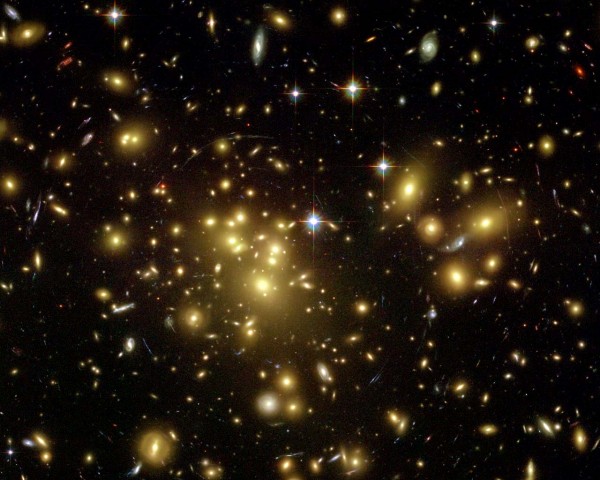
Because the prime evidence for dark matter doesn't come from the cosmic microwave background. It comes from galaxies, galaxy clusters and large-scale structure!
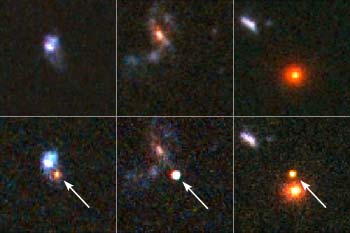
And the prime evidence for dark energy doesn't come from the cosmic microwave background, either. It comes from observations of supernovae and other very distant sources.
While the microwave background supports both of these, it isn't the foundation of a house of cards. Rather, it's an independent test that, thus far, has reached the same conclusions. And, having worked with this data myself, I can personally say I find it (and the various masks used) very compelling, and of overwhelmingly high quality.
So we've got to make sure we get the details ironed out so that we can have confidence in our confident claims, but we are way past the point where one bad data set will cause us to revise our picture of the Universe; the evidence is far too comprehensive and compelling at this point.
But we keep searching for anomalies and examining the suspicious ones we do find, because if we don't, that's when we stop learning. Just don't discount so easily what we already know!

Terrific post.
Great post, Ethan. Very well explained. I like to see the fire in the belly. This is why we try to develop independent lines of evidence. Avoids the whole house of cards problem.
Just for the record: the "howling lie" you quote is actually from a press release by the Royal Astronical Society of the U.K. You have messed with the Queen ...
You are absolutely pointing the disgusting thing out. Why are these people turning good science into bad science, just, to get some notoriety. The really annoying thing is that there are so many amazing things you can say about cosmology and the world we live in, as Ethan does in his blog, that is very sad to report lies in a sensationalism way, just to bring attention to a valid work.
It's well-known that Her Majesty personally oversees all RAS astrophysical press releases. It's part of our unwritten constitution.
The House of Lords is important, too - that's why it's called peer review.
I had to stare at the "problem area" figure for several seconds before I could spot any of the problem areas. These folks are worried about O(10) pointlike sources. OK, maybe they should be worried, but it's not going to overthrow any basic results. Maybe some of the fit parameters will shift, but the basic picture is intact.
As for that journamalist from PhysOrg, nonsense like that is how creationists, global warming denialists, et al., get a foot in the door. Somebody finds a small problem with a small part of the evidence and declares that the whole thing is bunk, when the great mass of independent evidence is not at issue. Good on you for calling him out.
The woman protesteth too much.
Yes nice summary. But...
Why attack the views of a messenger (i.e. an information officer) when you can attack the more serious views of serious physicists who have published peer reviewed articles, i.e. Fred I. Cooperstocks book and Fred Hoyle et al's book.
Attacking the opinion's of an astronomy information officer is little better than attacking the scientific opinion of a politician.
Love the passion for science, but "howling lie"? I'd simply term it as yet another less than fully substantiated professional opinion/conclusion.
My own fully unqualified gut feelings suspect that there is nevertheless a degree of smoothing inherent in what is seen and perhaps more than a little misunderstanding as to the full nature of the background "noise". Jumping on those presentations alone as full proof of anything can be deemed a bit simplistic, which is why I appreciate the pointing out here of so much additional evidence.
So what's the mathematical notation for as space-time approaches infinity, any transmission of energy and frequency ultimately decreases (insert various reasons here) to it's least detectable level?
This kind of thing is why I learned to never drink beer and play chess at the same time. Cosmic foam develops and it always gets to where you can't appreciate the underlying bubbles unless you have a clean glass.
@Thomas: As I've told you already several times now, Ethan has already looked at Cooperstock's ideas, and found them wanting.
And Ned Wright has looked at Hoyle et al.'s ideas, and found them wanting, too. (do I need to post the links again?)
Thomas,
S.w.a.b post about Fred Hoyle
8-)
Ethan, if you're so confident about Big Bang etc., what is the basis of your need to lie about the competition? Surely BB can stand on its own based on actual evidence.
Steady-state theorists posited an average temperature of (our neighborhood of) an indefinitely large and old universe, from which a near-perfect blackbody background would also arise, trivially. At the time the CMB was first measured, the favored T estimate among Big Bangers was ~50 K and rising (though one must admit they backpedalled with remarkable agility). The SS crowd had suggested various temperatures, mostly much closer to the measured value. The presence of a blackbody CMB by itself seems to demonstrate very little, despite vehement revisionism.
Similarly, isotope ratios. As estimates of cosmic isotope ratios have varied by quite large degrees, Big Bang has succeeded in adapting nimbly to each change, predicting the new value fully as confidently as the old. While an ability to stay consistent with the ratios du jour is important to the health of the theory, it doesn't seem actually to favor it over equally adaptable alternatives.
This is not to say that SS is better than BB. Rather, it's just that the discoveries you mention don't appear to be the smoking guns you say they are. I don't doubt that subtler smoking guns are really there, but you're burning credibility. Why not just present the actually persuasive evidence?
@Nathan Myers:
Why should the background radiation in a steady-state universe be so highly homogeneous? Our neighbourhood is anything but homogeneous, after all. And why should it be such a perfect blackbody spectrum? What reason is there is expect that our neighbourhood is in near-perfect thermal equilibrium?
That would be news to me. As far as I know, in the initial publication by Alpher, a range of 1 to 5 K was given, and only later did Gamov push the temperature up to about 50 K. Do you have evidence that this later value of Gamow was the "favored T estimate" at that time?
As far as I know, the main predictions (i. e. about 75% H and 25% He, and only very little amounts of other light elements) have been stable for most of the time. On the other hand, I've never seen even a sensible explanation of the H/He ratio from the steady state crowd, much less an explanation for all the other elements.
Bjoern
Thanks for reminding me of the Ned Wright's analysis of Hoyle and companies qausi steady state model. http://www.astro.ucla.edu/~wright/stdystat.htm
It clearly explains the problems with the QSS model and I don't dispute Ned's analysis.
David H
S.W.A.B. Hoyle, Burbidge and Narlikar's QSS modle as described in their 2004 book A Different Approach to Cosmology? And as well so what about Fred I. Cooperstock's 2009 book General Relativistic Dynamics: Extending Einstein's Legacy Throughout the Universe?
First, Hoyle: as far as I can tell (as a layman) Hoyle et al has done the ONLY SYSTEMATIC HIGH LEVEL OF PROFESSIONAL PHYSICS critique/alternative to the big bang theory that is backed by a pile of peer based articles. I value Hoyle's 2004 book not for his overall conclusion but for his detailed analysis of the problems of current big bang theory and with his own QSS theory as well. Thus what I find in Hoyle's book is a serious critique of the underlying ideas of the either cosmological theory. So while I'll agree with Ned Wright's analysis that overall the QSS's model is not correct; I also agree with Hoyle et al's that many of the ideas of either theory are problematic (e.g. about light elements, CMB or redshift). Do none of Hoyle et al's ideas merit discussion? Who else is the the loyal opposition with whom to have a dialogue if not Hoyle, Burbidge and Narlikar?
Now, Bjoern re: Cooperstock. "Ethan has already looked at Cooperstock's ideas, and found them wanting."
In a previous post Ethan explained that a paper on an alternative explanation for CMB, "didn't even consider whether black holes radiate enough power to account for the CMB, I got a sinking feeling in my gut... After doing the calculation, I realized that it's not going to work. If I instead model the galaxy as normal with these black holes distributed the way we think dark matter is distributed, I find that the power of the CMB would be too small by about fifty orders of magnitude. But my overall conclusion is -- unfortunately -- that it's a very bad paper." Such a criticism is very specific and makes sense, I trust Ethan's calculations. Where is the detailed criticism of Fred I. Cooperstock by Ethan or any astronomer physicist?
Ethan points to a nice website summary of dark matter observations beginning with J. H. Oort hypothesis that "more mass must be present in the galaxy than can be attributed to the visible matter."
Now as I understand Cooperstock, he has (pg 154-155) "shown that general relativity could accommodate typical galactic rotation curves with relatively small amounts of dark matter and hence not of the exotic variety that the description "dark matter" generally connotes... Our work brought into question the existence of large spherical halos of dark matter that are currently believed by probably most astronomers to surround the visible contents of galaxies. The question naturally arises: could general relativity also accomodate the presence of these massive external halos with the given flat rotation curves over a single plane? The answer is "yes." General relativity demonstrates its greater richness than Newtonian gravity in this way... We have seen that on the basis of the simple model, the observed Coma Cluster velocities can be rationalized with general relativity applied to only the visible contents of the systems."
I think such specific and peer reviewed published claims based on detailed general relativity calculations deserves a specific and peer reviewed rebuttal. Are there any? Not that I can find; but I'm just an amateur. So it seems the galactic halo data and the coma cluster only need general relativity not dark matter; unless you can point me to a credible critique. Thus my question: what is left of the dark matter hypothesis? Is 2% of the mass of the universe still missing or 4%?
Now my hypothesis is that astronomers (Ethan included) start with the physics assumption that Newtonian gravity must be adequate for the weak fields under consideration for galactic dark matter; and that they have thus never tested their galactic dark matter hypotheses with a detailed general relativity calculations. Well Fred I. Cooperstock, an emeritus general relativity professor, has tested the galactic dark matter hypothesis with general relativity and Cooperstock has found that the dark matter hypothesis is not needed at the galactic level. Now, the response of astronomer's has been to hold their breath hoping that someone else will refute Cooperstock's claim (e.g. maybe another general relativist physicist or the LHC will find dark matter). But as far as I can tell no one has refuted Cooperstock's calculations.
"Ethan has already looked at Cooperstock's ideas, and found them wanting." is a PR statement not specific scientific criticsim. Please point me to a web site critique or summary of the review article that counters Cooperstock's calculations and assertion that dark matter is not needed at the galactic level. Well? If it just ain't so; then why?
Another terrific post.
Can anyone clarify whether and how dark matter and dark energy affect one another? Similarly, do we know how local gravity (within the galaxy or cluster) affects dark energy? And if so, how do we know it? It seems like gravity might inhibit a gentle vacuum energy from working, like trying to lift a brick with a vacuum cleaner. Given that we believe there are huge amounts of both dark energy and dark matter surely someone has thought this through. Bjoern?
@Thomas:
Well, I think I can agree with that. But unfortunately, Hoyle's own model has far more problems than the big bang theory...
I don't have Hoyle's book. What about explaining some of the "problematic" things which Hoyle sees, e. g. about the CMBR? (would be on topic in this thread)
Ethan mentioned that he looked at Cooperstock's ideas, and found them wanting, in comment 20 here:
http://scienceblogs.com/startswithabang/2009/09/dark_matter_part_i_how_…,
and also in comment 9 here:
http://scienceblogs.com/startswithabang/2009/09/dark_matter_part_35_whe…
Both comments sound to me as if Ethan wrote something more about Cooperstock's ideas somewhere - but I can't find it on the blog. Ethan, could you please help out?
Bjoern: Why should the background radiation in a steady-state universe be so highly homogeneous? Our neighbourhood is anything but homogeneous, after all. And why should it be such a perfect blackbody spectrum? What reason is there is expect that our neighbourhood is in near-perfect thermal equilibrium?
I don't know at what scale you consider our neighborhood "anything but homogeneous". A radius of 1000 GLy is not too large if you have not already assumed BB. Why wouldn't you expect an infinitely old universe to be in equilibrium? Anything other than a blackbody spectrum would be suspicious. Deviations would need explanation just as for BB.
[the favored T estimate among Big Bangers was ~50 K and rising ...] That would be news to me. As far as I know, in the initial publication by Alpher, a range of 1 to 5 K was given, and only later did Gamov push the temperature up to about 50 K. Do you have evidence that this later value of Gamow was the "favored T estimate" at that time?
What part of "rising" do you not understand? It is Gamow's estimate that is always cited as having been demonstrated by CMB observations.
[As estimates of cosmic isotope ratios have varied by quite large degrees, Big Bang has succeeded in adapting nimbly to each change, predicting the new value fully as confidently as the old.] As far as I know, the main predictions (i. e. about 75% H and 25% He, and only very little amounts of other light elements) have been stable for most of the time. On the other hand, I've never seen even a sensible explanation of the H/He ratio from the steady state crowd, much less an explanation for all the other elements.
Every useful theory produces its own predictions, and they needn't cover precisely the same ground as other theories. What matters is whether they predict numeric values of observations. BB is promoted with "postdictions", which are nice, but not the same.
I'm not promoting SS. I'm asking what persuasive predictions BB has to its credit. Most usually the best I see is new observations favoring one BB variant over another, with some variant or other predicting every possible outcome. Why promote the unpersuasive evidence (and even falsehoods about the competition) if there's plenty that's persuasive?
Bjoern
Since you asked, "I don't have Hoyle's book. What about explaining some of the "problematic" things which Hoyle sees, e. g. about the CMBR? (would be on topic in this thread)."
Hoyle's book is written for the professional physicist; it is not an easy read; but I will try to summarize enough of his Chapter 8 The Cosmic microwave background-an historical account pg 79 to 94. Pg 82 to 94 are key. The book is available in preview form here http://books.google.com/books?id=lxzxg6iHc1MC&printsec=frontcover&dq=Ho…
Also, from google books online you can go to worldcat dot com and find which libraries worldwide have this book.
But let me summarize.
pg 82 & 83 (not in google online preview) "In the steady-state theory there should be no difference between galactic material considered locally, for which Y=0.25 (approx), and glactic material considered cosmologically... Y= .25... implying a universal helium mass density equal to one-quarter of baryonic density of visible matter, namely 7.5 x 10^-32 g cm^-3... The embarassment was that the energy desity of starlight was observed to be not greater than = (approx) 10^-14erg cm^-3.
"This embarassment was not faced until 1955, when Bondi, Gold and Hoyle admitted the difficulty, pointing out that an escape from it required a universal radiation background of energy density 4.5 x 10-13 erg cm^-3 to be present in the far infrared." The three authors disagreed upon what to publish and Gold's view was not published. "Had Gold's picture of nature being an arch-degrader of energy been follwed, a calculation of the resulting thermodynamic temperatures would have followed immediately."
"Since
aT^4 = 4.5 x 10-13 erg cm^-3 (equation 8.3)
and a = 7.564 x 10^-15 erg cm^-3 K^-4
T= 2.78K (equation 8.4)
had this elementary step been taken in 1955, it is easy to contemplate that when the cosmic microwave background was detected in 1965 to have a temperature somewhat below 3K, this estimate of T made in 1955 would have seemed stronger than estimates 'above 5K' of Gamow, Alpher and Herman made in 1948.... And ... big bang supporters would not have been able to hold center-stage to the extent that they actually have. And had Bondi, Gold, and Hoyle had the wit to recall McKellar's determination of 2.3K for the thermal excitation of CN, it is likely that the big-bang theory would not have been on-stage at all."
OK that's from pg 82 and 83 and the foundation idea of Hoyle's current CMB explanation. The next pages mostly viewable defend this position with a plausible mechanism and validate this idea with current data including COBE observations.
A few more relevant quotes. pg 85, "To point to a prediction of 4.5 x 10-13 erg cm^-3 for some form of an infrared background, as discussed, carried no weight in itself... The relevant facts remained hidden for years... only in the late 1980s, did what Bondi, Gold and Hoyle had been seeking in 1955 become at last available... The need was for a form of particle with a high absorption coefficient at micron wavelengths, significantly higher than at optical wavelengths, to produce the absorption and re-emission required for thermalization in the far infrared."
Hoyle goes on to explain what particles have been observed to do exactly this. I'm not fully understanding but he seems to be saying it is carbon whiskers and mostly iron whiskers or both.
pg 89 "If the iron whisker production is taken to as 0.1Msun per supernova and if the supernova production rate is taken as 1 per 30 years per galaxy, the total production per galaxy in 10^10 years is approx 2/3 x 10^41 g, By the term galaxy here is implied a major galaxy, of which spatial density is about 1 per 10^75 cm^3. Hence the expected whisker density, taking the whiskers to be expelled from their parent galaxy by radiation pressure, become
2/3 x 10^41 x 10^-75 = (approx) 10-34 g cm^-3
The calculated density is therefore seen to be approx 10-34 g cm^-3, as assumed above. If this had no relevance to the microwave problem, it would be yet another accident. "
OK, that iron whiskers seem to be Hoyle's core cause of the thermal 2.73K background radiation (if I understand Hoyle correctly).
Next Hoyle explains how all of this is in accord with the COBE data (at least up to publication in 2004).
OK that's my summary of Hoyle. I think I've understood Hoyle correctly. To me, his explanation of CMB is better than having to shrink the universe to the size of a peanut and raise its temperature to millions of degrees. His explanation involves only known science of absorption of starlight and re-emission by known particles produced by supernova.
fascinating and enlightening post as always...
Bjoern
Yes, Ethan commented 9/24/2009 regarding Cooperstock, "My conclusion? His model is interesting in principle, but he applies it incorrectly. It is possible to have the thing he suggests, but it is not a galaxy." Why not, I protest; that really isn't an explanation of what is wrong with Cooperstock's model. Unless you accept Ethan's preposterous suggestion that Cooperstock doesn't know what a galaxy is, "but it is not a galaxy." This is a copout criticism. Does Ethan seriously suggest that Cooperstock did all of the general relativity calculations correctly but that he accidently used the wrong definition of a galaxy? To paraphrase Ethan Siegel, "I'm calling you out Ethan Seigel."
And then in the another blog post 9/30/2009 Ethan comments, "I've already gone through the problems with Cooperstock & Tieu's paper; do you have an alternative? "
Where did Ethan go through the problem with Cooperstock's paper, obviously I missed something or Ethan doesn't want to explain.
In an 9/27/2009 email, thanking me for my positive review of his book, Cooperstock commented, "You should know that while we have answered all of our critics, to my knowledge, there has not been any counter-criticism, at least not in print."
So why am I surprised that Ethan or some blog expert won't answer my stubborn question. I ask again, what is wrong with Cooperstock's general relativity calculation that shows that general relativity explains most of the phenomenon associated with galactic dark matter without a need for exotic dark matter. Anyone out there have a substantive answer?
Of course writiing a peer review article or just writing a serious blog explanation to a serious scientific question is a lot harder than "smacking" down an idea.
@Nathan Myers:
Since when is "a radius of 1000 GLy" our neighbourhood? Strange choice of words... Even on cosmic scales, "our neighbourhood" usually means at most 100 MLy.
Because we see that all the time, things are changing - old stars are exploding, new stars are forming, supermassive black holes are sometimes more, sometimes less active. How can the universe be at thermal equilibrium if all of these perturbations happen all of the time?
You said that it wa "50 K and rising", implying that there were predictions for even *higher* values than 50. But the highest value I have ever heard (and even that only as an upper bound!) was Gamow's 50 K. And please support your claim that it "is Gamow's estimate that is always cited as haveing been demonstrated by CMB observations", specifically that the 50 K by Gamow are cited in that regard.
Right. But complaining that the BBT can't get the abundance of light elements right, but on the other hand ignoring that the SS can't even get the abundance of H and He right, looks a bit strange, don't you think?
Please explain what exactly you mean with "postdictions".
Well, for starters the one you dispute: the existence of the CMBR and the abundance of elements. I, for one, think that both are persuasive - simply because no other model so far has managed to predict these things in any sensible way.
If you want more, you could try to look here:
http://www.talkorigins.org/faqs/astronomy/bigbang.html
@Thomas:
Thanks for the hint. Unfortunately, the book only seems to be available in 6 libraries in all of Germany - and the nearest one is about 250 kilometers away...
Thanks for your quotes - but I can't follow the argument. How, exactly, did they arrive at the prediction of an energy density of 4.5 x 10-13 erg cm^-3? What has that do to with the helium density?
Please don't misrepresent the Big Bang Theory. In the BBT, for producing the CMBR, you have to heat the universe only to about 3000 K, not to "millions of degrees", and at that age, its diameter would still be millions of light years, not "the size of a peanut". Further, in some newer variations of the steady state model (the "quasi steady state"), Hoyle et al. *also* propose a universe which was far smaller and far hotter in the past - *very* similar to the usual Big Bang theory.
But the Big Bang explanation for the CMBR *also* involves only known science of absorption and emission of radiation by known particles. I don't see the big difference here. And even worse: Hoyle's "iron whiskers" model doesn't work. See here: http://www.astro.ucla.edu/~wright/stdystat.htm (that's the page I've mentioned already several times now...); start reading at the paragraph "If the QSSC..." and go on till "...what Narlikar et al. is doing."
Bjoern
OK, that reveals the limits of my attention span and my comprehension. I obviously didn't fully understand either Ned Wright or Hoyle.
I defer to Bjoern's interpretation.
regarding your two questions, 1)"How, exactly, did they arrive at the prediction of an energy density of 4.5 x 10-13 erg cm^-3?"
I don't really understand what they are saying because I get confused when they are explaining the history of the various theories versus what they currently think. But let me grab a straw. There is a remark, "Gold argued in favor of a thermalized background, because nature always turns out to be more efficient at degrading the quality of energy than we expect it to be." Apparently this remark leads to the 4.5 x 10^-13 erg cm^-3. I really do not understand what they are talking about. sorry.
2)"What has that do to with the helium density?" ditto here on my lack of understanding. It seems that a 1955 Bondi, Gold and Hoyle paper reference Observatory, 75, 80 explains this.
on pages 201-207 Hoyle give their current (2004) version of "The origin of the microwave background". I didn't quote from that section because frankly I didn't understand anymore from that section than I did from the earlier pages and there was more detail that I didn't have a clue what it meant.
Better understanding is always good. But as I reread Ned Wright words and charts, and understanding a little better, it's discouraging that this QSS model is the best alternative to BBT.
Personally, I am still skeptical of BBT; but scientifically I do defer to your judgement.
Also, your remarks, "In the BBT, for producing the CMBR, you have to heat the universe only to about 3000 K, not to "millions of degrees", and at that age, its diameter would still be millions of light years, not "the size of a peanut". Further, in some newer variations of the steady state model (the "quasi steady state"), Hoyle et al. *also* propose a universe which was far smaller and far hotter in the past - *very* similar to the usual Big Bang theory." are well taken.
Thank you Bjoern.
Bjoern: You must have missed "if you have not already assumed BB". For the purpose of CMB, "our neighborhood" refers to the free path of those microwave photons between interactions with cosmic dust. They don't interact much, so you need lots of room. In SS, supernovas and star formation are presumed to have been going on forever, so events, even supernovas, average out, the same as atomic collisions. As with BB, any measured isotope ratio can be made consistent with the theory after the fact, but as with BB it tells you nothing about the validity of the theory. "Rising" can only mean that earlier estimates were lower than later estimates. 50K was the last estimate not overtaken by events.
A "postdiction" occurs when the theory is successfully adjusted to produce the values measured. I can understand your confusion, as this is called a "prediction" in astronomy, although nowhere else.
Bjoern
One last Hoyle, Burbidge, Narliker quote, which I can't knowledgeably evaluate, on pg 207 the authors summarize, "So how much does this set QSSC ahead of the big bang? By the standards currently operative in big-bang cosmology, in which nothing connected with the background has been proved, but only assumed ad hoc, a very long way indeed."
Now I don't understand what is ad hoc. So I am left wondering so who is telling the most half truths. And yes, I see my own biases. Let me say no more about the CMB for a while. I'll just listen to your open reasoning. I hope you can get your hands on a copy of Hoyle's book.
Thanks again.
@Thomas:
Defer to ed Wright, not to me - *he* is the expert cosmologist, I'm only a particle physicist with some knowledge in cosmology...
(oh, and I also don't understand why Hoyle et al. call the BB model of the CMBR "ad hoc"...)
@Nathan Myers:
Thanks for explaining that and sorry for the misunderstanding. However, I *still* think that calling "radius of 1000 Gly" our "neighbourhood" is rather strange! And it's not entirely clear to me where the figure of 1000 Gly comes from - is that a crude estimate, or did you or someone else actually calculate that this is the mean free path length?
Sorry, I don't understand how these events can "average out". If the CMBR is emitted all the time at the same temperature, but sometimes with a different temperature due to local events, we should see different temperatures when we look at different directions - not essentially the same temperature everywhere, I'd think.
So how does the SS explain the ratio of H to He today? And the fact that essentially all abundances of elements go to zero if one looks at older stars, whereas the abundance of H goes to 75% and the abundance of He to 25%?
Well, I'm not a native English speaker, so perhaps I misunderstand something here - but "50 K and rising" still implies to me that you meant "there was a value of 50 K and later there were even larger values".
Well, if you see it that way, then quite a lot of measurements in physics are postdictions, since quite a lot of measurements are used to adjust parameters in a theory. And no, this does *not* only happen in astronomy, this also happens e. g. in particle physics.
Additionally, you seem to ignore here that in order to predict the abundances of the elements, one needs only very few parameters. These few parameters can be determined by using measurements of only some abundances - and then one can use these determined parameters to predict the abundances of all the other elements. So the BBT does *not* merely use "postdictions" in this respect.
Bjoern: I *still* think that calling "radius of 1000 Gly" our "neighbourhood" is rather strange!
Please recall, again, that we're not assuming BB. 1000 Gly is a negligibly short distance in an infinite universe.
"And it's not entirely clear to me where the figure of 1000 Gly comes from - is that a crude estimate, or did you or someone else actually calculate that this is the mean free path length?"
Just a number.
Interpretation of "and rising" does not depend on details of English. Rather, it's a matter of sampling: was the "first difference/derivative" using the last estimate recorded, and any other, positive or negative?
If you assume a statistically static, uniform universe, then any object floating in inter-supercluster space necessarily has the same temperature as any other, and that temperature implies a blackbody radiation curve. Even if SS proponents did not publish any such prediction, it's implied by the model. It's only the deviations from blackbody that provide clues. Therefore, it's actively dishonest to insist that the presence of CMB itself distinguishes BB from SS.
[As with BB, any measured isotope ratio can be made consistent with the theory after the fact] So how does the SS explain the ratio of H to He today? And the fact that essentially all abundances of elements go to zero if one looks at older stars, whereas the abundance of H goes to 75% and the abundance of He to 25%?
Please correct me if I'm mistaken, but as I understand it, the isotope predictions don't actually depend on a Big Bang having occurred shortly before, but only on details of the environment in which each light nucleus forms. In other words, if in each place where light nuclei form, these conditions obtain, then they need not form all at the same time. Since this is another postdiction (as the 75/25% number was known before BB) we only need to create nucleons in spots where the right conditions obtain.
We don't really know why some stars lack metals. It's convenient to guess that they must be older because they lack metals. Circular reasoning is tempting, but I hope you can see why it is to be avoided.
To me, you start getting persuasive evidence when you find indications of blackbody temperature increasing continuously with distance, such as suggested by SZ.
@Nathan Myers:
This has nothing to do with "assuming BB" or not. Even if we assume the BB, the universe could still be infinitely large, and even then I'd say that "radius of 1000 Gly" is not "our neighbourhood".
Pardon? Do you want to imply that if the figure went up from the second-to-last to the last value, then one is justified to say that the figure was the last figure "and rising"? Makes no sense to me, sorry.
I don't see how that should follow, sorry. If it were *completely* static, I'd agree. But merely "statistically static" isn't enough, in my opinion - and I explained above why I think so.
Well, it depends on the universe having been much hotter and much denser at some time in the past. I don't see how that could be compatible with SS, whereas it makes perfect sense in the BBT.
Well, then you need to explain why when we look at greater distances, i. e. more into the past, we see less and less heavy elements, but the H and He abundance stays roughly constant.
So you think you can simply ignore that this fact is perfectly consistent with the BBT, but very hard to explain in the SS model...?
Err, don't you know that we can *measure* the age of stars? There is no "guessing" involved there.
Err, but there *are* already some measurements which show that the CMBR has a higher temperature at greater distance! Haven't you heard of that? Here is one example (there are others, but I'd have to search for them a while): http://arxiv.org/abs/astro-ph/?0012222
Bjoern: there *are* already some measurements which show that the CMBR has a higher temperature at greater distance.
Yes, that's what I said. Such evidence is difficult to reconcile with a steady-state model, and it is such evidence that should be presented as persuasive. The presence of a CMB, by contrast, is extraordinarily weak evidence, and presenting it as definitive amounts to revisionism.
@Nathan Myers: I explained above why I don't think a SS model implies a CMBR (and so far you have not explained where my reasoning is wrong, only claimed that the perturbations somehow "average out", however that should work). So I still think it's sensible to say that the existence of a homogeneous, blackbody CMBR is evidence for the BBT, but against a SS model.
Additionally, you apparently still ignore several of my arguments about (primordial) nucleosynthesis.
I would like to correct you on all your work. the world was not created by a bang it was created by the God. He made the heavens and the Earth. There has nothing to do with a band. This hypothesis will always be a theory because there is a God. His son Jesus Christ died for our sins so yyou are allowed to live right now. If he would have not died for our sins you would be gone in a flash for thinking that the big bang theory was true. You can read all about Jesus in a book called the Holy Bible, then I will pray that you will change all your ideas.
CE @ 31:
Nor does your post demonstrate anything having to do with mental health. Make sure your mom knows that your prescriptions need refilling!